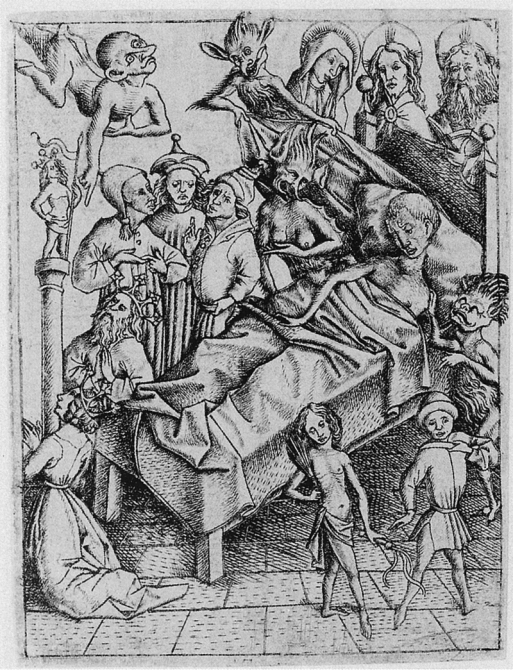
Temptation or lack of faith, one of the five temptations of the Ars moriendi, engraving circa 1450
(Credit: en.wikipedia.org)
The Ars Moriendi (“The Art of Dying”) are two Latin texts dating back to 1415 and 1450, written to guide Christians through the process of “dying well,” according to Christian tenets of the late Middle Ages. The books inform the dying about what to expect as they transition, and offers prayers and prescribes mental attitudes and consolations. It also outlines deathbed etiquette for the family members and friends of the dying person. It is the first guide to death and dying in the Western literary tradition of such guides.
To fill the deficit, “paper-priests”–pamphlets containing prayers and penances — were distributed, circulating through households all over Europe.
In the aftermath of the Black Death, there was a shortage of priests, who typically performed the “last rites” which ensured salvation. To fill the deficit, “paper-priests”–pamphlets containing prayers and penances — were distributed, circulating through households all over Europe. The development of Gutenberg’s printing press allowed the pamphlets and the Ars Moriendi to fill the gaps left by the thinned-out clergy.
The Ars Moriendi seeks to assuage spiritual anxiety rather than amplify it, by highlighting the efficacy of repentance in winning salvation rather than focusing on Hell and eternal torment, as much earlier medieval Christian literature did. It offers a manual that organizes the dying process into an intricate systematic structure, which serves as a container that reduces some of the fear around the unknown. It breaks death and dying down into a series of specific, manageable steps in a highly ordered procedure that helps focus the energy of the dying person and allows him or her to feel some agency over his or her own death.

The invention of the Gutenberg printing press allowed the first version latin text on Ars Moriendi (The Art of Dying) to be distributed after the Black Death
(Credit: flickr.com)
The original “long version” of the Ars Moriendi was written in 1415 Germany by an anonymous Dominican friar. It includes six chapters:
1. Chapter one consoles the dying person, explaining that death is not something to be afraid of, and that there are some positive aspects to death.
2. Chapter two lists the five temptations faced by dying people and how to resist them. The five temptations listed are lack of faith, despair, impatience, spiritual pride and avarice.
3. Chapter three outlines seven questions to present to the dying person. These questions revolve around commitment to orthodox faith, fear of the Lord, genuine contrition, commitment to living piously, forgiveness of enemies, restoration of ill-gotten goods to others and belief that Christ died for their sins.
4. Chapter four expresses the importance of emulating Christ, offering examples of the five things Christ did on the cross. These five were: 1) prayers, 2) inward calls to God, 3) external weeping, 4) committing his soul to God, and 5) dying willingly
5) Chapter five addresses family and friends of the dying person, prescribing etiquette at the deathbed.
6) Chapter six consists of prayers to be said for the dying person.
Each pair consists of one picture of the devil presenting one of the five temptations and the other picture showing the antidote to that temptation.
The “short version” of the Ars Moriendi is from the Netherlands and dates back to 1450. The “short version” is comprised of eleven woodcut pictures. The images are instructive and can be easily explained and memorized. The appearance of the “short version” of the Ars Moriendi just precedes the introduction of block books in the 1460s. The first five woodcuts are divided into five pairs. Each pair consists of one picture of the devil presenting one of the five temptations and the other picture showing the antidote to that temptation. The last woodcut is of a man, having successfully avoided succumbing to temptations, being welcomed into heaven and the confused devils scurrying back to Hell.
Because the Roman Catholic clergy was hit particularly hard by the Black Death, the dearth of priests to attend to dying people required an innovative solution. The Ars Moriendi was one solution. Thus, the Ars Moriendi begins the Western literary tradition of manuals to prepare for death and dying, on what it meant to die a good death, and protocols for dying well.

 The Ars Moriendi, or “The Art of Dying”
The Ars Moriendi, or “The Art of Dying”



 “As Tears Go By” by Marianne Faithfull
“As Tears Go By” by Marianne Faithfull

 Funeral Favors Offer Visitors a Tangible Memento
Funeral Favors Offer Visitors a Tangible Memento















